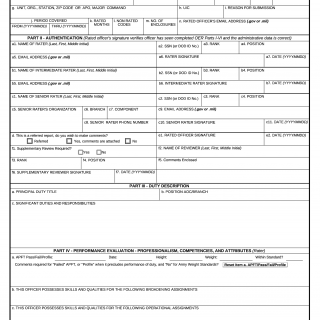DA Form 67-10-2. Field Grade Plate (O4 - O5; CW3 - CW5) Officer Evaluation Report
DA Form 67-10-2, also known as the Field Grade Plate (O4 - O5; CW3 - CW5) Officer Evaluation Report, is a United States Army form used for evaluating officers of field-grade rank or higher. The primary purpose of this form is to provide an objective assessment of an officer's performance and potential in their current position.
The form consists of several parts, including administrative data, duty description, performance evaluation, potential evaluation, senior rater comments, and overall performance summary. It is important to fill out all sections accurately and thoroughly to ensure a fair and accurate evaluation.
The parties involved in the evaluation process include the rated officer, the rater, and the senior rater. The rated officer is the subject of the evaluation, while the rater is typically the immediate supervisor. The senior rater is usually the next level of supervision above the rater.
When filling out the form, data such as the rated officer's name, rank, and duty position must be provided. Other important fields include specific details of the officer's duties and responsibilities, as well as an evaluation of their performance and potential.
Additional documents that may be required include support forms from the rated officer's subordinates and peers, as well as any relevant correspondence or awards.
Examples of application and use cases of this form include promotion boards, command selection boards, and other career development opportunities. It is crucial for officers to receive accurate evaluations to help them progress through their careers and achieve their professional goals.
Strengths of the DA Form 67-10-2 include its comprehensive nature and clear guidelines for evaluation. Weaknesses may include potential biases or inaccuracies in the evaluation process.
Alternative forms may include the Officer Evaluation Report Support Form (DA Form 67-10-3) and the Strategic Grade Plate (O6 and Above) Officer Evaluation Report (DA Form 67-10-1). Differences between these forms may include the rank of the evaluated officer and the level of detail required in the evaluation.
The results of the evaluation can greatly affect the future of the rated officer, potentially leading to promotions or career setbacks. The form is typically submitted through official military channels and stored in the officer's personnel record.
Overall, the DA Form 67-10-2 plays a crucial role in the evaluation and development of Army officers in field-grade positions.

